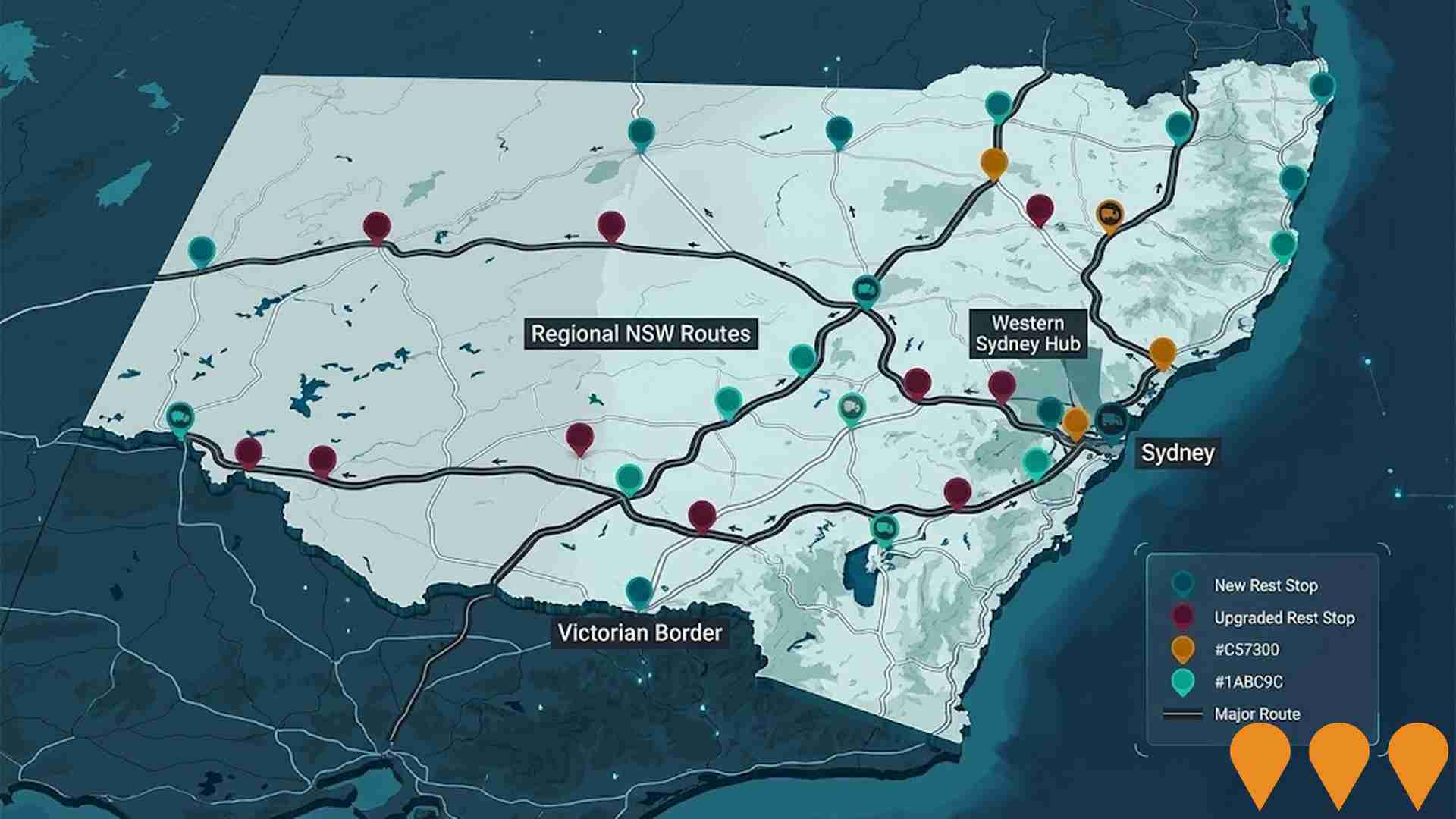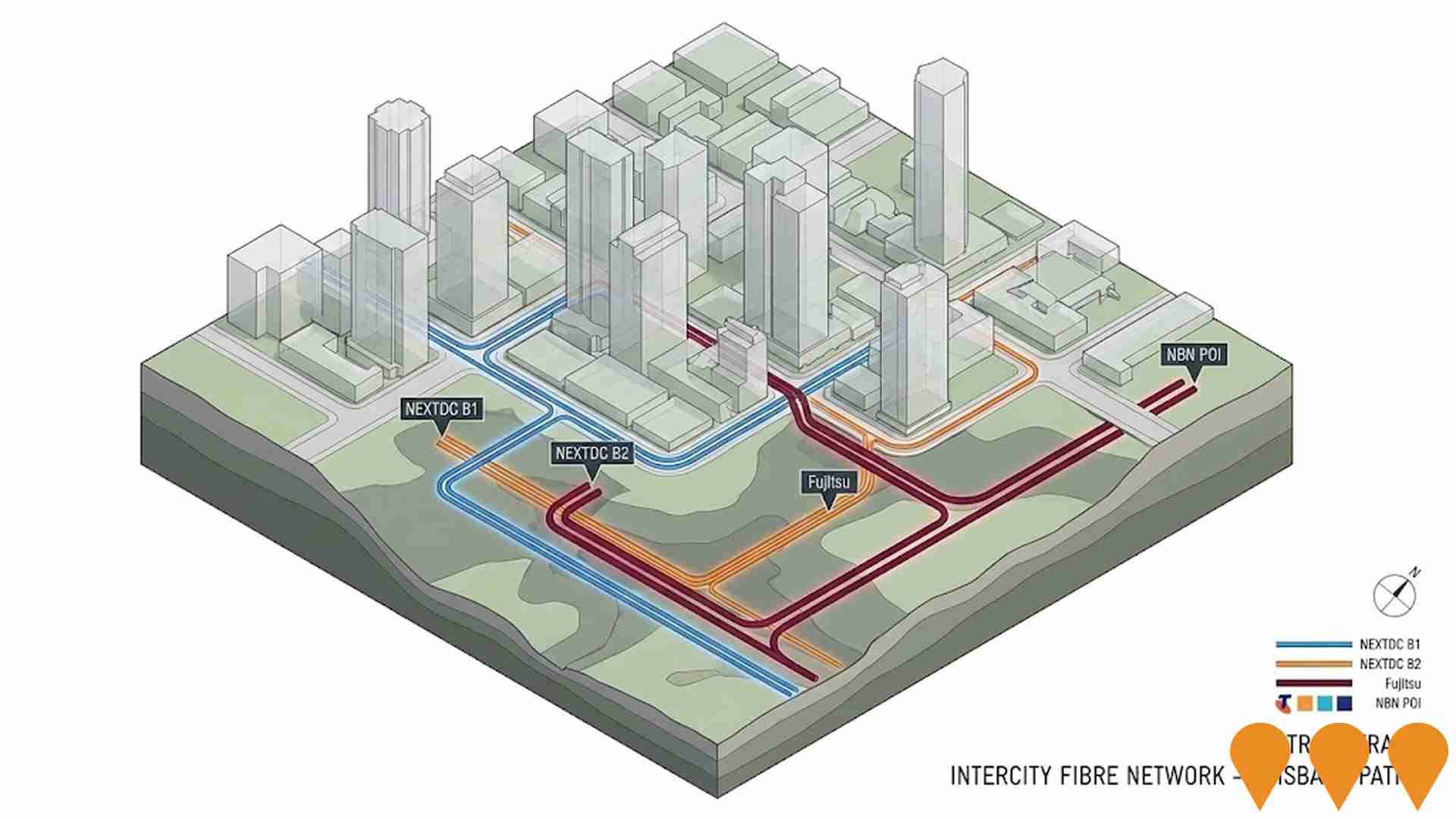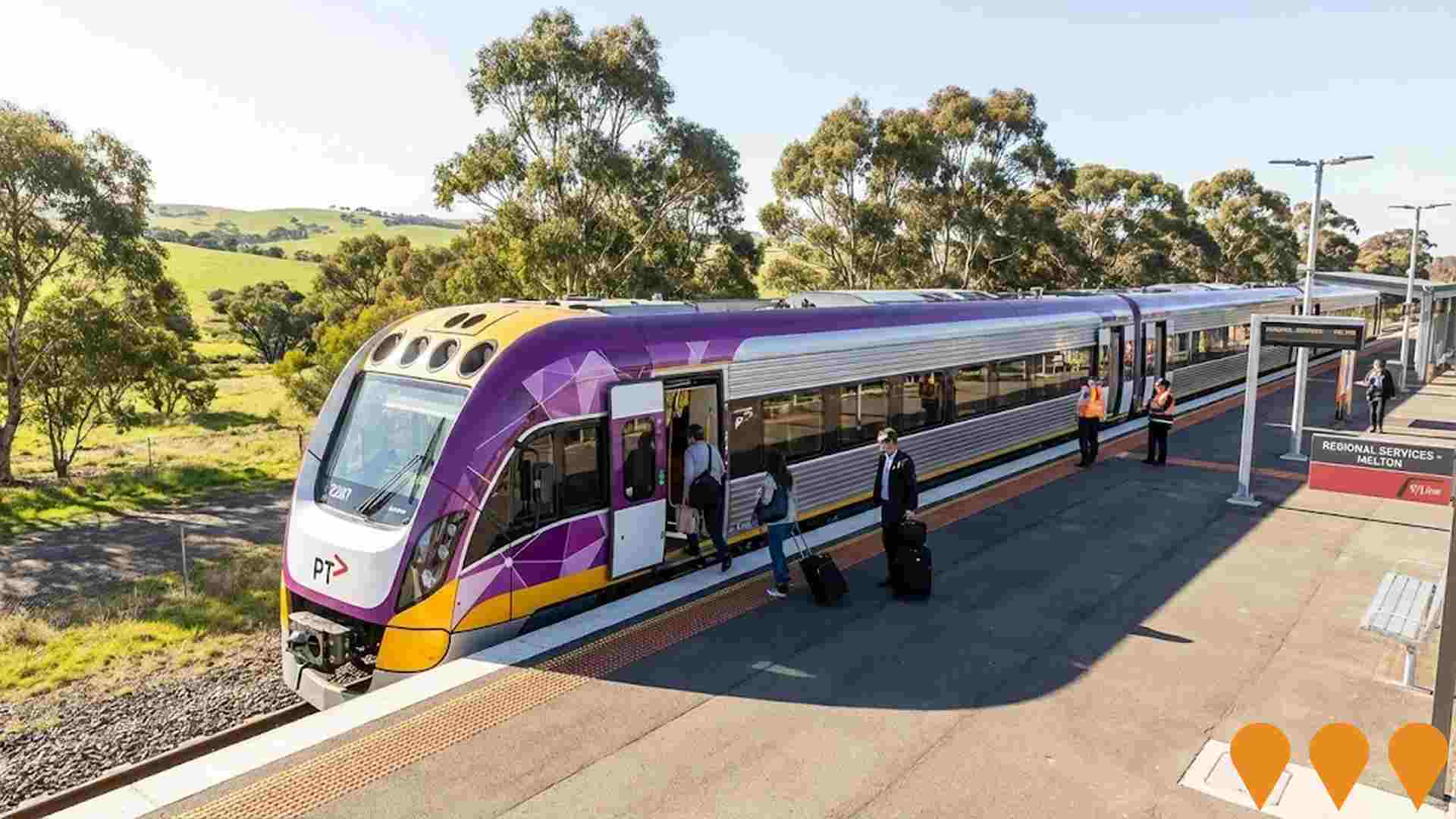Chart Color Schemes
est. as @ -- *
ABS ERP | -- people | --
2021 Census | -- people
Sales Activity
Curious about local property values? Filter the chart to assess the volume and appreciation (including resales) trends and regional comparisons, or scroll to the map below view this information at an individual property level.
Find a Recent Sale
Sales Detail
Population
Corowa has shown very soft population growth performance across periods assessed by AreaSearch
Corowa's population, as per AreaSearch's analysis, is approximately 5,638 as of November 2025. This figure represents an increase of 43 individuals, a growth rate of about 0.8%, since the 2021 Census which reported a population of 5,595. The change is inferred from the estimated resident population of 5,548 as of June 2024 and an additional 28 validated new addresses since the Census date. This results in a population density ratio of approximately 73 persons per square kilometer, indicating significant space per person and potential room for further development. The primary driver of population growth was interstate migration, contributing roughly 58.7% of overall population gains during recent periods.
AreaSearch is utilizing ABS/Geoscience Australia projections for each SA2 area, released in 2024 with a base year of 2022. For areas not covered by this data, AreaSearch employs the NSW State Government's SA2 level projections, released in 2022 with a base year of 2021. Growth rates by age group from these aggregations are applied to all areas for years 2032 to 2041. Looking ahead, population projections indicate a decline over this period. According to the methodology used, Corowa's population is expected to decrease by 628 persons by 2041. However, growth across specific age cohorts is anticipated, notably in the 85 and over age group which is projected to increase by 178 people.
Frequently Asked Questions - Population
Development
The level of residential development activity in Corowa is very low in comparison to the average area assessed nationally by AreaSearch
Corowa has recorded approximately 10 residential properties granted approval each year over the past five financial years, totalling 54 homes. As of FY26, 4 approvals have been recorded. The population has fallen during this period, suggesting new supply has likely kept pace with demand, offering good choice to buyers. New properties are constructed at an average expected construction cost value of $348,000.
This financial year, $12.6 million in commercial development approvals have been recorded, indicating moderate levels of commercial development compared to the rest of NSW. Corowa shows substantially reduced construction activity (66.0% below regional average per person), which generally supports stronger demand and values for established properties. This activity is also below national averages, reflecting the area's maturity and possible planning constraints. Recent building activity consists entirely of standalone homes, preserving the area's low density nature with an emphasis on detached housing attracting space-seeking buyers. Developers are constructing more detached housing than the existing pattern implies (84.0% at Census), reflecting persistent strong demand for family homes amid densification trends.
The estimated count of 704 people per dwelling approval reflects Corowa's quiet, low activity development environment. With population expected to remain stable or decline, Corowa should see reduced pressure on housing, potentially creating opportunities for buyers.
Frequently Asked Questions - Development
Infrastructure
Corowa has emerging levels of nearby infrastructure activity, ranking in the 37thth percentile nationally
Changes in local infrastructure significantly impact an area's performance. AreaSearch has identified four projects expected to influence the region: JBS Rivalea Corowa Grower Farm, Corowa Battery, Corowa Regional Saleyards Redevelopment Project, and Corowa Solar Farm. The following details these key initiatives.
Professional plan users can use the search below to filter and access additional projects.
INFRASTRUCTURE SEARCH
 Denotes AI-based impression for illustrative purposes only, not to be taken as definitive under any circumstances. Please follow links and conduct other investigations from the project's source for actual imagery. Developers and project owners wishing us to use original imagery please Contact Us and we will do so.
Denotes AI-based impression for illustrative purposes only, not to be taken as definitive under any circumstances. Please follow links and conduct other investigations from the project's source for actual imagery. Developers and project owners wishing us to use original imagery please Contact Us and we will do so.
Frequently Asked Questions - Infrastructure
Victorian Renewable Energy Zones
VicGrid, a Victorian Government agency, is coordinating the planning and staged declaration of six proposed onshore Renewable Energy Zones (plus a Gippsland shoreline zone to support offshore wind). The 2025 Victorian Transmission Plan identifies the indicative REZ locations, access limits and the transmission works needed to connect new wind, solar and storage while minimising impacts on communities, Traditional Owners, agriculture and the environment. Each REZ will proceed through a statutory declaration and consultation process before competitive allocation of grid access to projects.
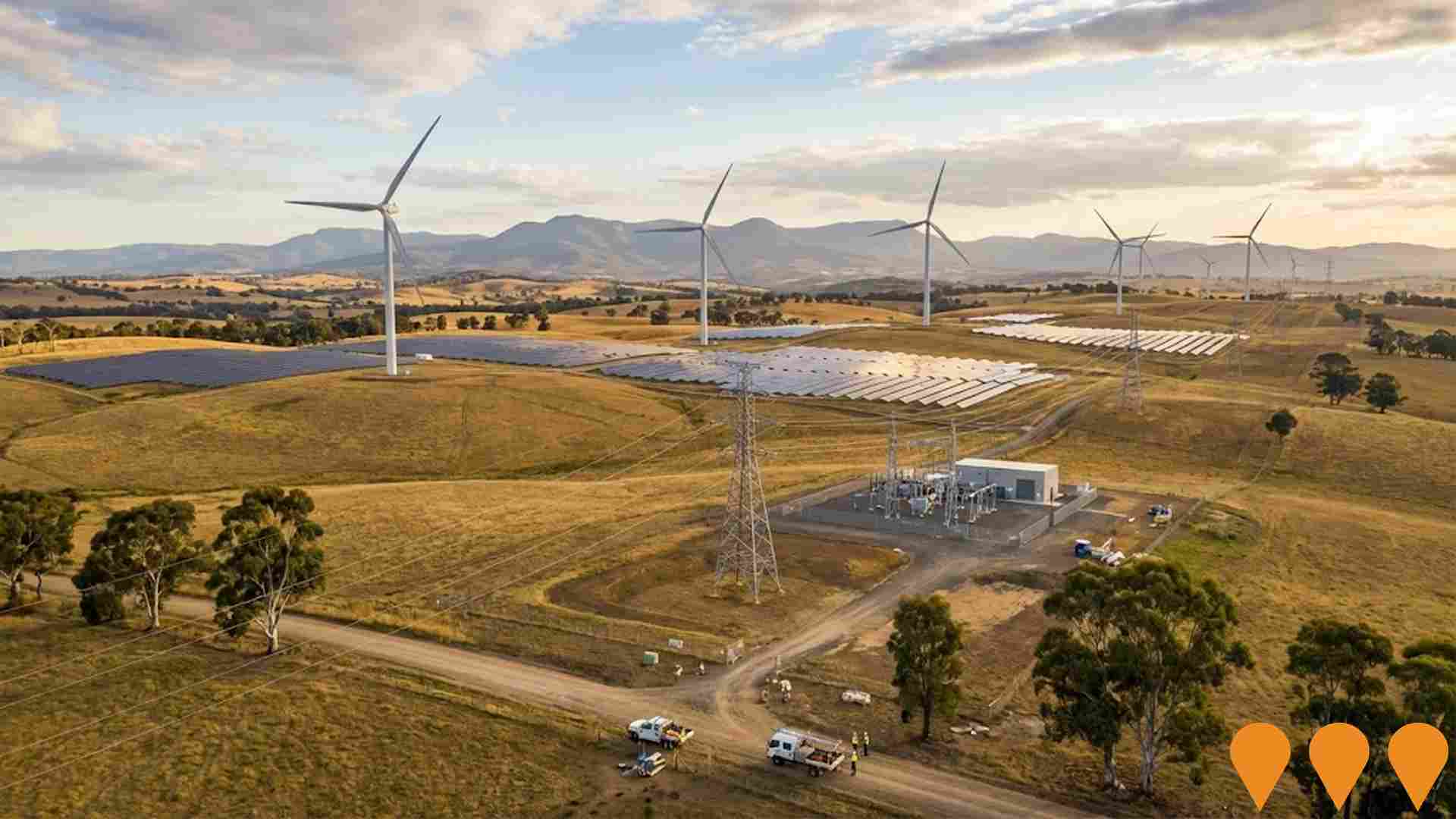
North East Rail Line Upgrade
Major upgrade to the North East Rail Line between Melbourne and Albury-Wodonga, improving freight and passenger services, including track resurfacing, mud-hole removal, drainage improvements, bridge upgrades, and signalling enhancements to allow VLocity trains and better ride quality.
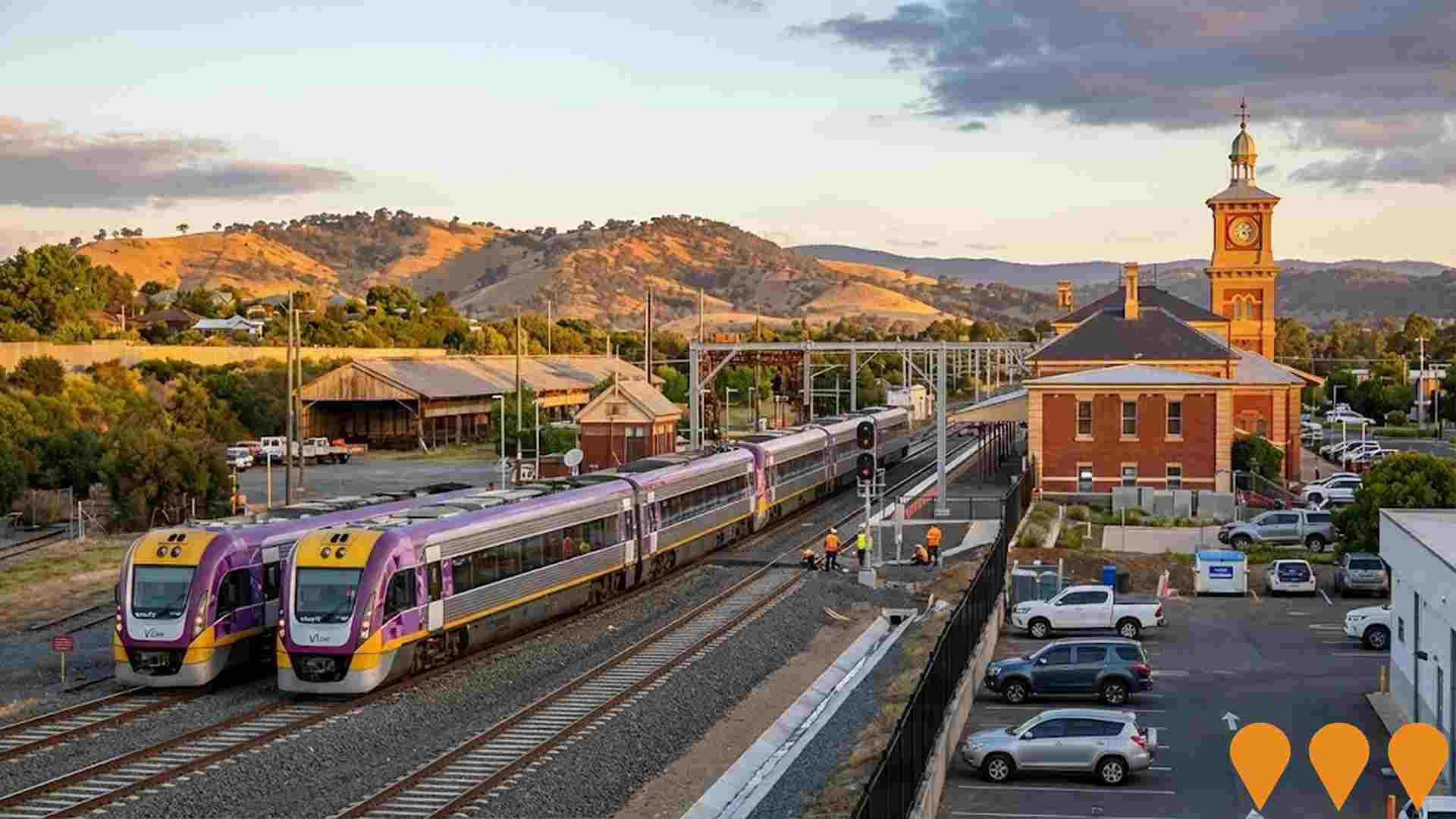
Corowa Regional Saleyards Redevelopment Project
The redevelopment includes a 23,662 square metre roof over livestock pens, a new office building, an expanded truck wash for biosecurity, and other operational improvements to protect stock and enhance welfare, positioning it as a premier sheep selling centre with training opportunities.
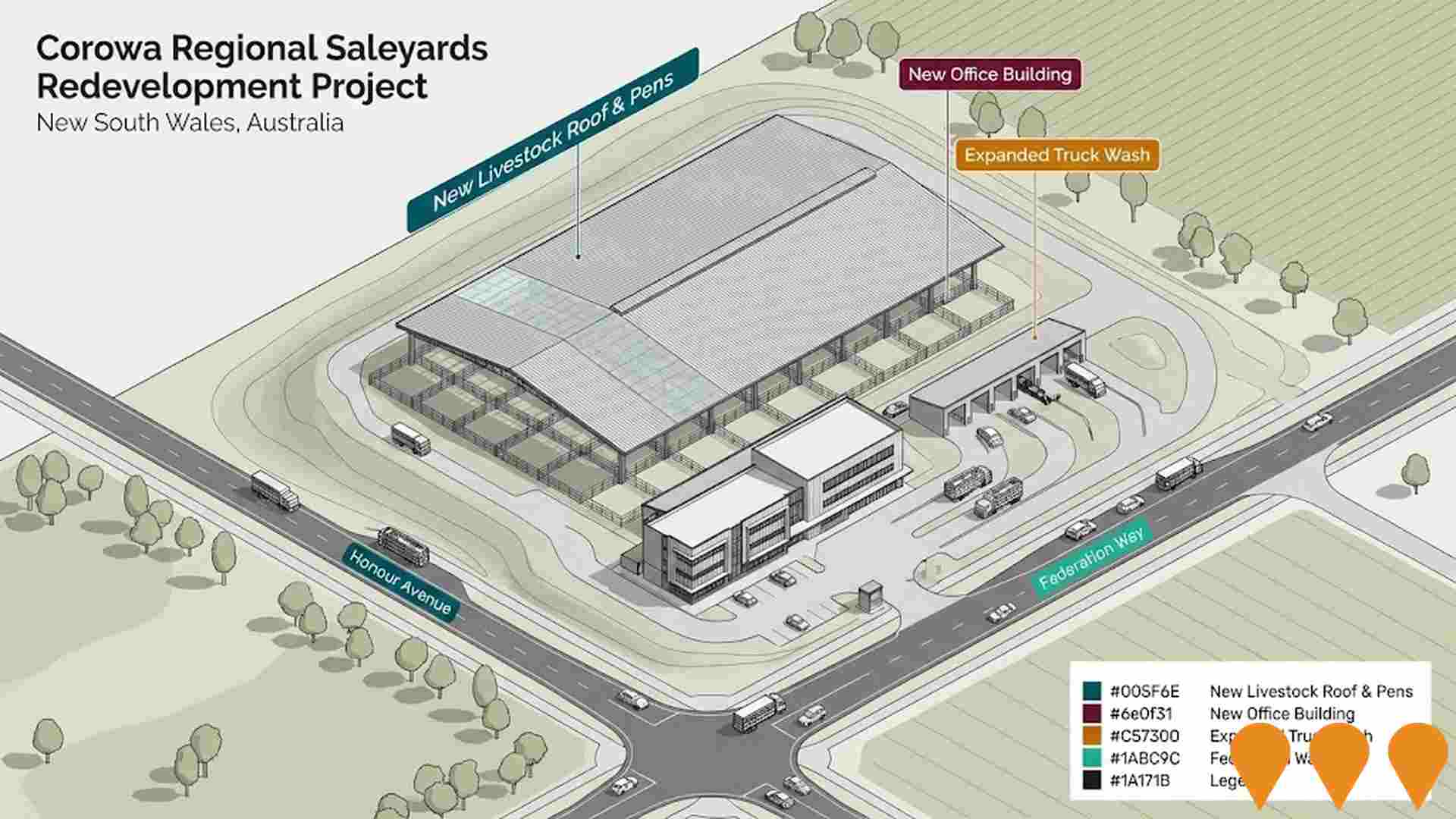
VNI West (NSW section)
NSW portion of the VNI West interconnector: a proposed 500 kV double-circuit transmission line linking Transgrid's Dinawan Substation (near Coleambally) to the NSW/Victoria border north of Kerang, with associated upgrades including works on Transmission Line 51 near Wagga Wagga and expansion works at Dinawan Substation. The NSW Environmental Impact Statement (EIS) is on public exhibition in August 2025, and Transgrid has announced staged delivery with Stage 1 to Dinawan/South West REZ by early 2029 and Stage 2 to the Victorian border aligned to November 2030.
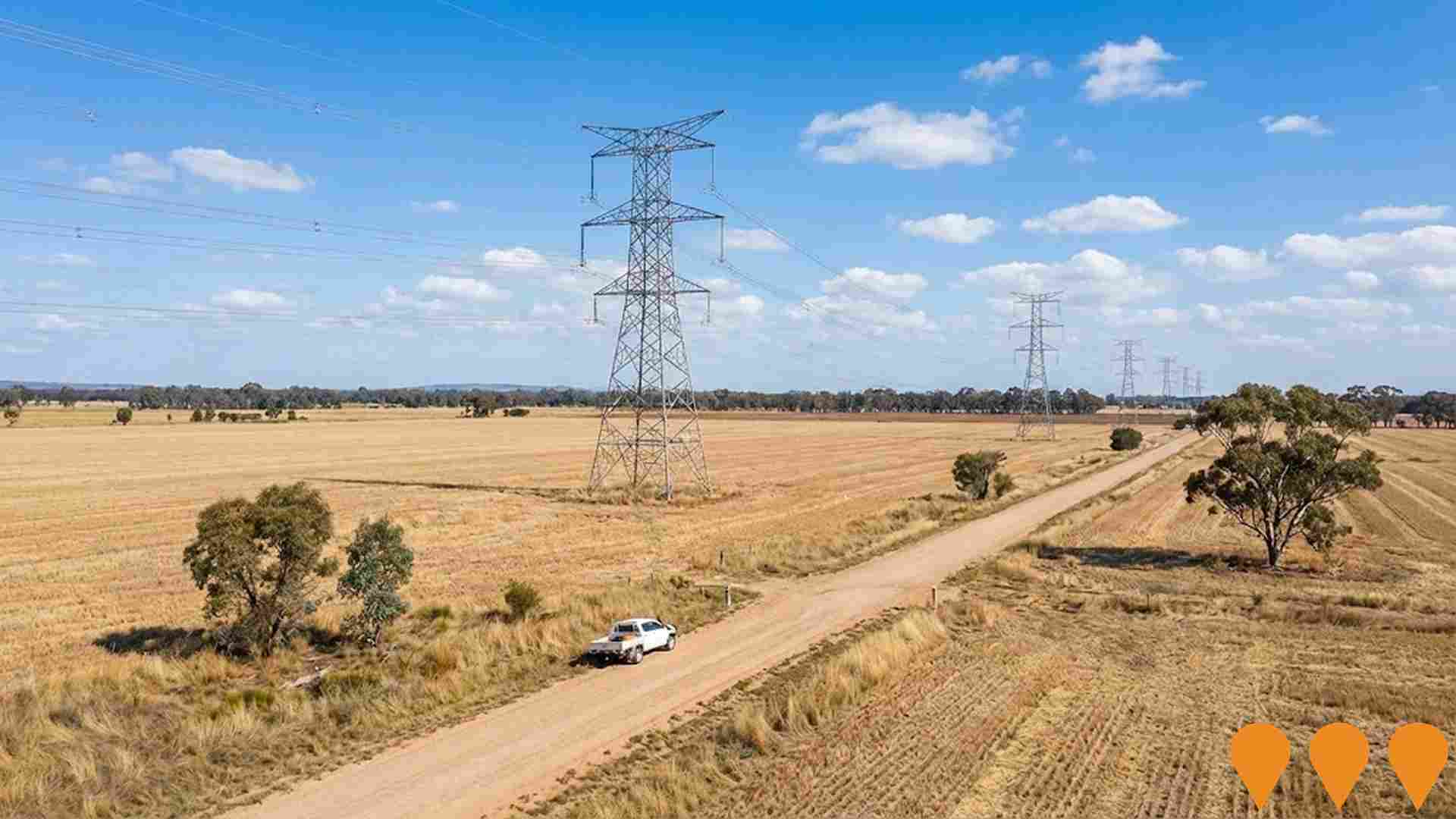
JBS Rivalea Corowa Grower Farm
The JBS Rivalea Corowa Grower Farm project involves modernizing pork farming operations at Corowa, NSW. This includes building state-of-the-art growing and breeding facilities to improve sustainability, biosecurity, animal welfare, environmental performance, and staff safety. Key features include separating growing and breeding farms for better biosecurity, replacing ageing infrastructure in stages, enhancing environmental performance through circular economy systems like nutrient recycling and wastewater treatment, and aligning with industry-leading standards for work health and safety.
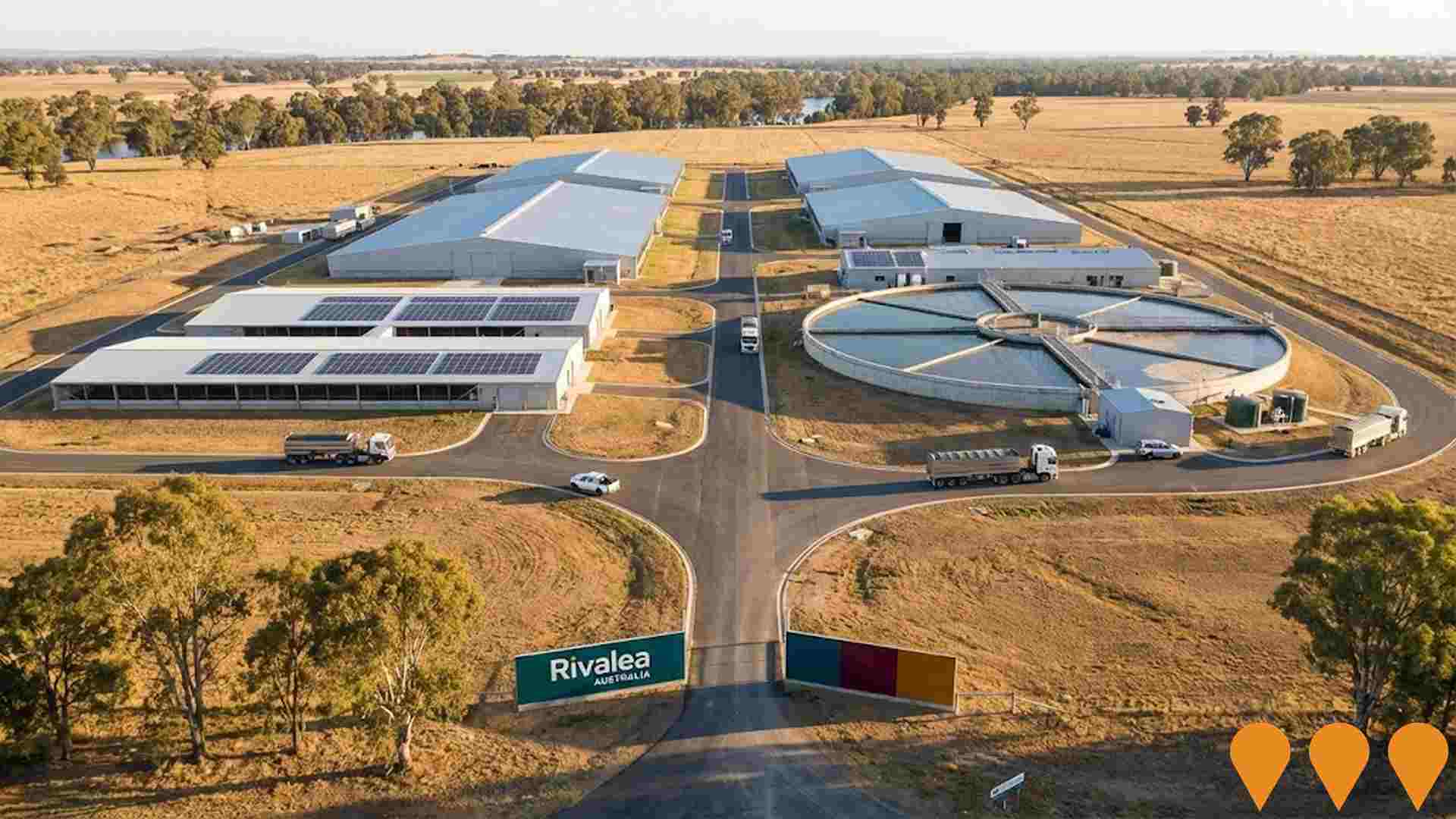
Corowa Battery
Proposed construction of a 100 MW / 200 MWh battery energy storage system (BESS) adjacent to the Corowa Substation on Wiradjuri country. The project aims to support renewable energy integration, reduce peak demand strain, enhance grid stability through Frequency Control Ancillary Services (FCAS), and create local jobs during construction.

EnergyConnect
Australia's largest energy transmission project. A new ~900km interconnector linking the NSW, SA and VIC grids. NSW-West (Buronga to SA border and Red Cliffs spur) was energised in 2024-2025, connecting the three states via the expanded Buronga substation. NSW-East (Buronga-Dinawan-Wagga Wagga) is under active construction with substation upgrades at Wagga Wagga completed in June 2025 and works well advanced at Dinawan and Buronga. Full 800MW transfer capability is targeted after completion of the eastern section and inter-network testing, expected by late 2027.

Corowa Solar Farm
A 39 MW ground-mounted solar PV project over 92 hectares, expected to power 13,000 households and offset 59,000 tons of CO2 emissions annually. The project features a single axis tracking system and connects to the grid via Essential Energy's substation.
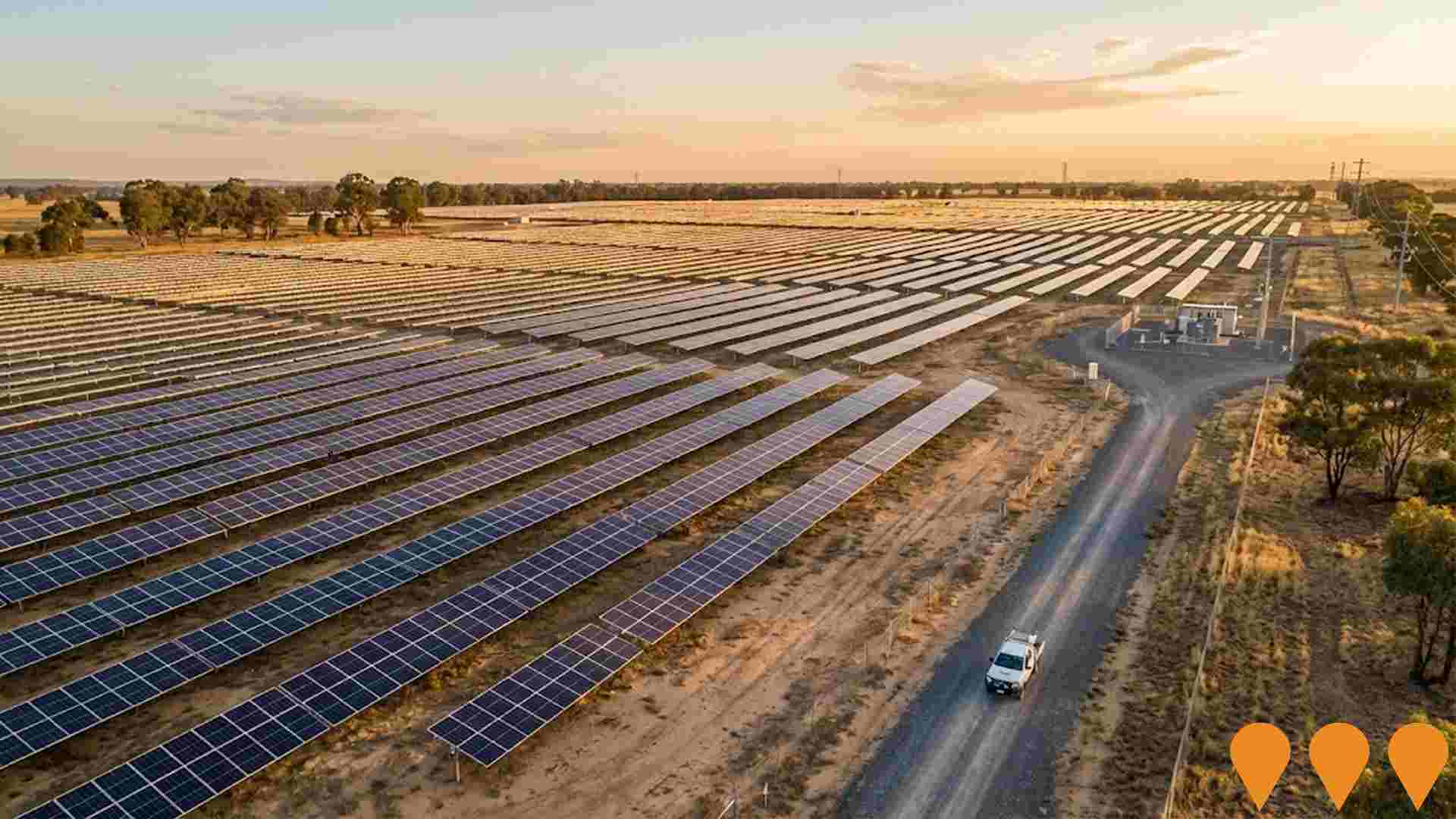
Employment
Employment conditions in Corowa remain below the national average according to AreaSearch analysis
Corowa's workforce is balanced across white and blue collar jobs, with manufacturing and industrial sectors prominent. The unemployment rate was 3.9% in the past year, with an estimated employment growth of 4.2%.
As of June 2025, 2,846 residents are employed, with an unemployment rate of 3.7%, 0.2% above Rest of NSW's rate. Workforce participation is lower at 51.3%, compared to Rest of NSW's 56.4%. Leading industries include manufacturing, health care & social assistance, and retail trade. Manufacturing is particularly specialized with an employment share 3.3 times the regional level.
Health care & social assistance has a limited presence at 13.3% compared to the regional 16.9%. Many residents commute elsewhere for work based on census data. In the year ending June 2025, employment increased by 4.2%, while labour force grew by 4.4%, leading to an unemployment rise of 0.3 percentage points. This contrasts with Rest of NSW where employment contracted by 0.1%, and unemployment rose by 0.4 percentage points. National employment forecasts from Jobs and Skills Australia, May 2025, project national growth of 6.6% over five years and 13.7% over ten years. Applying these projections to Corowa's employment mix suggests local growth of approximately 5.1% over five years and 11.7% over ten years.
Frequently Asked Questions - Employment
Income
The area's income levels rank in the lower 15% nationally based on AreaSearch comparative data
Corowa's median income among taxpayers was $47,077 in financial year 2022. The average income stood at $55,888 during the same period. These figures compare to national averages of $49,459 and $62,998 respectively for Rest of NSW. Based on Wage Price Index growth of 12.61% since financial year 2022, estimated median income is approximately $53,013 as of September 2025, with average income at around $62,935 during the same period. Census data indicates household, family and personal incomes in Corowa fall between the 9th and 16th percentiles nationally. The $1,500 - $2,999 income bracket dominates with 27.8% of residents (1,567 people), consistent with broader trends across the region showing 29.9% in the same category. Housing costs are modest, allowing for retention of 88.0% of income. However, total disposable income ranks at just the 13th percentile nationally.
Frequently Asked Questions - Income
Housing
Corowa is characterized by a predominantly suburban housing profile, with a higher proportion of rental properties than the broader region
Corowa's dwelling structure, as per the latest Census, consisted of 83.7% houses and 16.2% other dwellings (semi-detached, apartments, 'other' dwellings). In comparison, Non-Metro NSW had 89.8% houses and 10.2% other dwellings. Home ownership in Corowa was 47.4%, with the rest being mortgaged (28.0%) or rented (24.7%). The median monthly mortgage repayment in Corowa was $1,213, below Non-Metro NSW's average of $1,285. The median weekly rent figure in Corowa was $230, compared to Non-Metro NSW's $235. Nationally, Corowa's mortgage repayments were significantly lower than the Australian average of $1,863, while rents were substantially below the national figure of $375.
Frequently Asked Questions - Housing
Household Composition
Corowa features high concentrations of lone person households, with a lower-than-average median household size
Family households constitute 62.0% of all households, including 18.7% couples with children, 32.3% couples without children, and 10.3% single parent families. Non-family households account for the remaining 38.0%, with lone person households at 35.8% and group households comprising 2.1%. The median household size is 2.1 people, which is smaller than the Rest of NSW average of 2.3.
Frequently Asked Questions - Households
Local Schools & Education
Corowa faces educational challenges, with performance metrics placing it in the bottom quartile of areas assessed nationally
The area faces educational challenges, with university qualification rates at 12.0%, substantially below the NSW average of 32.2%. This represents both a challenge and an opportunity for targeted educational initiatives. Bachelor degrees are most common at 8.6%, followed by graduate diplomas (1.8%) and postgraduate qualifications (1.6%). Trade and technical skills feature prominently, with 40.9% of residents aged 15+ holding vocational credentials – advanced diplomas (9.1%) and certificates (31.8%).
A substantial 22.9% of the population actively pursues formal education, including 8.3% in primary education, 7.4% in secondary education, and 1.6% pursuing tertiary education. Corowa's 4 schools have combined enrollment reaching 657 students as of a recent report. The area demonstrates typical Australian school conditions (ICSEA: 973) with balanced educational opportunities. Education provision is balanced with 3 primary and 1 secondary schools serving distinct age groups. School capacity exceeds typical residential needs, with 11.7 places per 100 residents compared to the regional average of 9.4, indicating the area serves as an educational center for the broader region.
Frequently Asked Questions - Education
Schools Detail
Nearby Services & Amenities
Transport
Transport servicing is low compared to other areas nationally based on assessment of service frequency, route connectivity and accessibility
Corowa has 83 active public transport stops, all of which are bus stops. These stops are served by 25 different routes that together offer 265 weekly passenger trips. The accessibility of the transport system is rated as excellent, with residents typically living just 163 meters from their nearest stop.
On average, there are 37 trips per day across all routes, which equates to approximately three weekly trips per individual stop.
Frequently Asked Questions - Transport
Transport Stops Detail
Health
Health performance in Corowa is a key challenge with a range of health conditions having marked impacts on both younger and older age cohorts
Corowa faces significant health challenges, with various conditions affecting both younger and older age groups. Private health cover is low, at approximately 48% of the total population (~2,706 people), compared to the national average of 55.3%.
The most prevalent medical conditions are arthritis (12.1%) and mental health issues (9.3%). While 57.2% of residents report no medical ailments, this is lower than the Rest of NSW figure of 60.6%. Corowa has a higher proportion of residents aged 65 and over at 32.4% (1,828 people), compared to the Rest of NSW average of 30.5%.
Frequently Asked Questions - Health
Cultural Diversity
The latest Census data sees Corowa placing among the least culturally diverse areas in the country when compared across a range of language and cultural background related metrics
Corowa had a cultural diversity index below the average, with 92.0% citizens, 91.6% born in Australia, and 97.2% speaking English only at home. Christianity was the predominant religion, comprising 59.3% of Corowa's population, compared to 58.1% across Rest of NSW. The top three ancestry groups were English (33.5%), Australian (33.2%), and Irish (9.9%).
Notable differences existed in the representation of Scottish (9.0% vs regional 9.2%), German (3.3% vs 3.0%), and Welsh (0.5% vs 0.3%) groups.
Frequently Asked Questions - Diversity
Age
Corowa ranks among the oldest 10% of areas nationwide
The median age in Corowa is 52 years, which is significantly higher than the Rest of NSW average of 43 years and also above the national norm of 38 years. Compared to the Rest of NSW average, the 75-84 age cohort is notably over-represented in Corowa at 12.4%, while the 35-44 age group is under-represented at 8.5%. This concentration of the 75-84 age group is well above the national average of 6.0%. Between 2021 and present, the percentage of the population in the 75 to 84 age group has grown from 10.8% to 12.4%, while the 5 to 14 age cohort has declined from 10.3% to 9.4%. Population forecasts for the year 2041 indicate substantial demographic changes for Corowa, with the 85+ age group projected to grow by 68%, adding 167 residents to reach a total of 414. Senior residents aged 65 and above will drive all population growth, highlighting demographic aging trends. Conversely, both the 35-44 and 0-4 age groups are expected to see reduced numbers.


